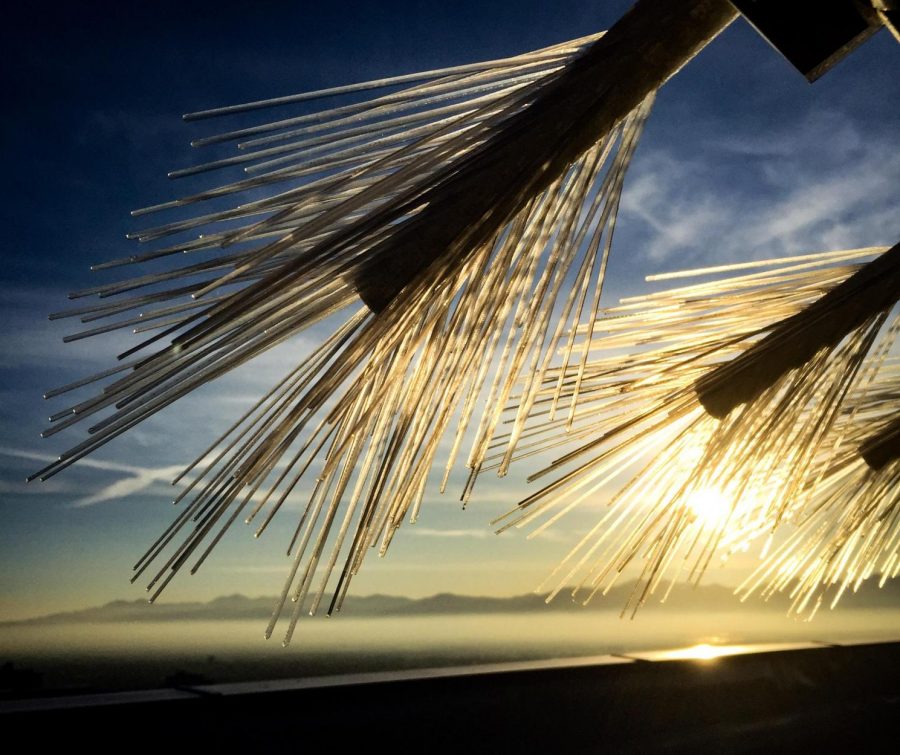U Research Shows the Role of Pine Needles in Air Filtration
Lippert’s team builds synthetic pine needles to model the magnetism of natural pine needles. (Photo courtesy of Pete Lippert)
October 22, 2020
According to the American Lung Association’s “Most Polluted Cities” list, Salt Lake City ranked No. 11 for ozone and No. 7 for short-term particle pollution out of the approximately 19,000 cities in the United States.
Peter Lippert, associate professor of geology and geophysics, and his team of three students at the University of Utah hope to change the way this is experienced by the Salt Lake population.
Alongside Lippert were Brendon Quirk, Courtney Wagner, and Grant Rea-Downing, graduate students at the U who conducted research on the magnetization of pine needles to try to quantify the amount of air pollution in Salt Lake Valley.
Both Wagner and Rea-Downing read about research done on Broadleaf trees in the UK while taking Lippert’s class.
“This paper kind of came at the right time. I was just starting to think about bad air quality and what it could mean for folks. We read this paper and it got me really energized,” Rea-Downing said.
After talking with some other interested students, they jointly submitted a proposal for a grant from the Global Change & Sustainability Center.
“About six months after that class, they approached me like hey we have this idea and the Global Change & Sustainability Center has these student grants, is this something that we can do?” Lippert said.
Both Rea-Downing and Wagner independently realized this would make for an interesting Ph.D. thesis.
The idea behind the research is there is particulate matter in the air, which gets deposited on different surfaces — one of those being pine needles.
“For this study, the students selected some areas on campus to sample like right next to a really busy road, North Campus Drive, to a more quiet part of campus to see if we can measure a gradient in particulate matter,” Lippert said.
The team samples pine needles from these trees and studies the particulate matter, which contains iron, on each one. The researchers then apply a strong magnetic field to enhance the iron’s natural magnetization.
“So, it’s a combination of magnetic methods, chemistry and microscopy, all of which we can do really well in our labs here at the U,” Lippert said.
The research was split into phases with the first attempting to see if the pine needles could be an accurate indicator of air quality in Salt Lake, which proved to be successful.
One main finding of this research is the iron component of the particulate matter is most likely from automobile exhaust.
“Our initial results are consistent with the source being from automobile exhaust, primarily, not just like dust coming in from the West Desert and things like that but actually products of combustion,” Lippert said.
Lippert is excited about the findings in this research because it opens the door for citizen science.
“We can go into neighborhoods and identify where there are trees that we could sample and talk to people that have those trees on their property or work with the city and collect a dense network of needles to assess just how much particular matters people in these communities are interacting with,” Lippert said.
This research also underscored the importance of trees.
“Trees are great because they provide shade, which fades heating and cooling costs, a beautified landscape, and they help clean the air for us and so they can protect us from pollution, particularly near roads and other industrial sites,” Lippert said.
Wagner suggested if a homeowner lives near a busy road, they should plant more trees and shrubs between their house and the road to lessen the effects of the poor air quality.
“One of the things we can do in addition to wearing masks is plant more trees. One of the proof of concepts of our research is that plants, trees, evergreens do trap a lot of the pollution out of the air,” Wagner said.
While the pine needles are not necessarily able to predict bad air quality, they can be studied after bad air quality events to show which areas of the valley get hit the hardest. This has important implications for those who have health issues that may be exacerbated by bad air quality.
“When there are poor air quality events, what neighborhoods are most significantly impacted by these events, and then design to improve the quality of life and lower the risk that people in those neighborhoods face when we have future air quality events,” Lippert said.
Air pollution can also cause major health effects that could lead to Dementia and Alzheimer’s.
“Iron-based particulate matters have been associated with a lot of health effects that range from cardiovascular disease to pulmonary disease, even neurodegeneration,” Lippert said.
Lippert suggests planting more trees and changing traffic patterns as ways of mitigating the bad air quality events in certain neighborhoods.
The second and current phase of the research is focusing on how long pine needles hold onto the pollution from a particularly bad air quality event. This also involves investigating whether the pine needle method is sensitive enough to show the decrease in pollution after COVID-19 related shutdowns.
Lippert and his team do not know what is in store for them after phase two, but they may focus on working with epidemiologists, community planners and members of the engineering and climate science faculty at the U to apply their research.
The team also built synthetic pine needles to see if they could model the magnetism of natural pine needles. They found it to be unsuccessful, revealing the biology that is in play here.
“The greener your landscape, the better your air. Trees actually do a very nice job of filtering your air for you,” Rea-Downing said.
This student-led research holds implications for the future of Salt Lake, and the team is excited about future findings.
“What’s really neat is how this has really started off as a student-led project that is emergent and something potentially really big and the possibility for citizen science and providing low-cost solutions for a big problem that impacts everyone in the valley,” Lippert said.








